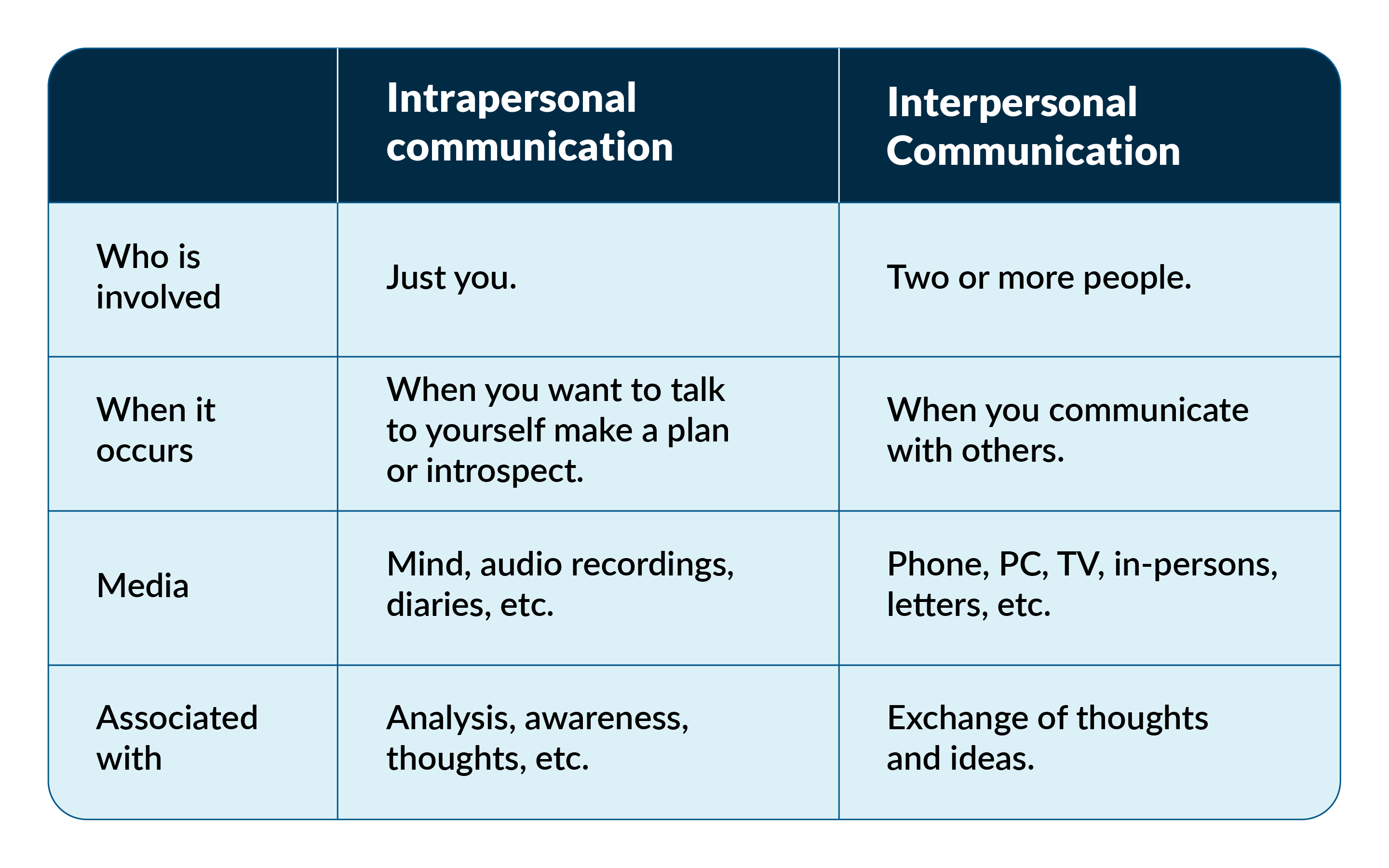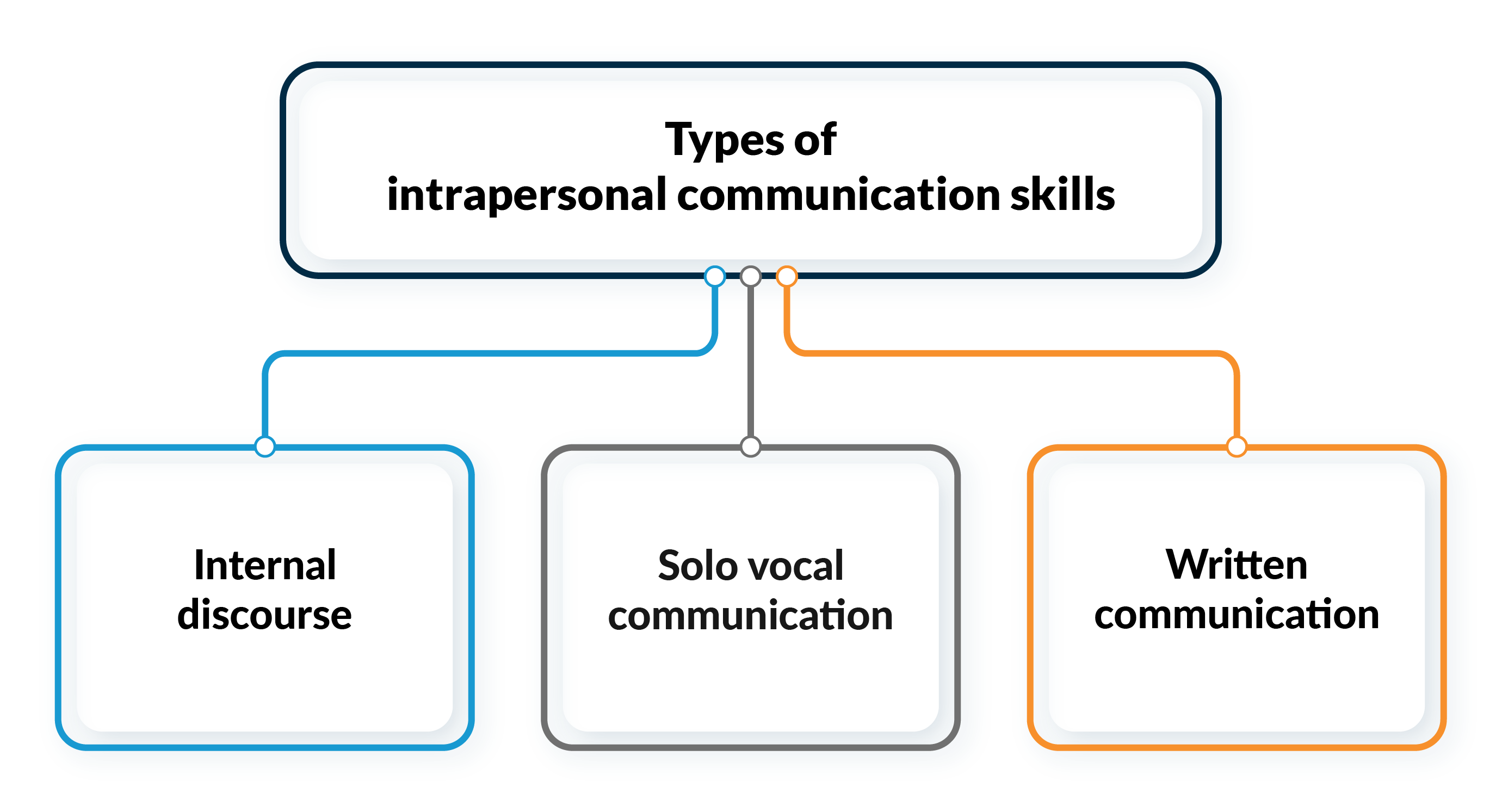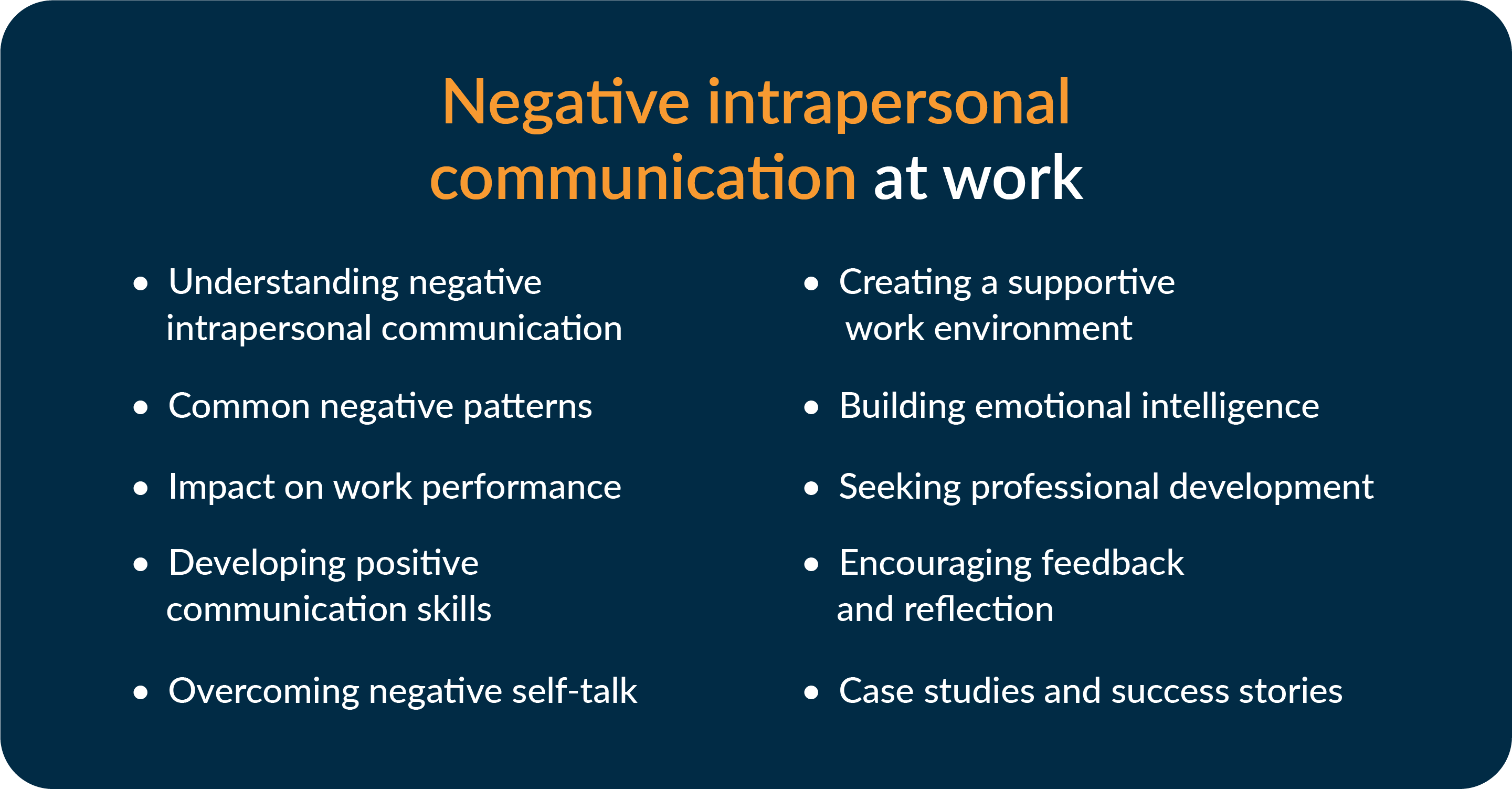What is Intrapersonal Communication? Skills, types, and examples

Imagine you're standing in front of a mirror. What do you see? More importantly, what do you say to yourself? The words, thoughts, and feelings that run through your mind in these moments are all part of a fascinating process known as intrapersonal communication. It's something we all engage in every day, yet it's often overlooked.
Let's take a journey into your inner world. Buckle up—this isn’t just any article. We’re going to explore what intrapersonal communication really is, how it shapes your life, and, most importantly, how you can harness it to become the best version of yourself.
What is intrapersonal communication?
Intrapersonal communication is communication with oneself. It’s the internal dialogue that takes place in your mind, often referred to as self-talk or inner speech. This type of communication is crucial because it influences how you perceive and react to the world around you. Whether you're reflecting on a past experience, planning for the future, or processing your emotions, you're engaging in intrapersonal communication.
At its core, intrapersonal communication helps you build a better understanding of who you are and what you want from life. It’s not just about thinking; it’s about thinking constructively—analyzing your thoughts and feelings, evaluating your actions, and making informed decisions.
Intrapersonal and interpersonal communication
While intrapersonal communication is your internal dialogue, interpersonal communication involves the exchange of information between two or more people.
Interpersonal communication is what happens when you chat with a friend, discuss a project with a colleague, or share your thoughts in a group setting. It's social interaction at its core. In contrast, intrapersonal communication is private and personal, occurring within your mind. It's the voice that speaks to you when you're alone, the thought process that guides your decisions, and the self-reflection that shapes your identity.
Understanding this distinction is key because how you communicate with yourself directly influences how you communicate with others. If your internal dialogue is positive and supportive, you're likely to approach interpersonal interactions with confidence and clarity. On the other hand, if talking to self is filled with doubt and negativity, it can impact your relationships and communication with others.

Why is intrapersonal communication important?
Intrapersonal communication is the foundation of your mental and emotional well-being. It helps you process experiences, understand your emotions, and make decisions. By improving these communication skills, you can enhance your self-awareness, manage stress, and cultivate a positive self-concept.
Moreover, intrapersonal communication plays a vital role in personal growth. By regularly reflecting on your thoughts and actions, you can identify areas for improvement, set meaningful goals, and track your progress over time. In essence, effective intrapersonal communication is a key component of achieving success and fulfillment in both your personal and professional life.
Types of intrapersonal communication skills
Intrapersonal communication encompasses different approaches we use to process thoughts and feelings. Here’s a look at some key types that shape our inner dialogue and self-reflection. These skills play a vital role in personal growth, decision-making, and understanding our own perspectives.

Internal discourse: Reflective thinking and analysis
Internal discourse is a type of intrapersonal communication where you engage in reflective thinking and analysis. This process involves considering various aspects of a situation, weighing your options, and analyzing potential outcomes. It’s an essential part of decision-making and problem-solving.
For instance, when you're faced with a difficult choice—like whether to accept a new job offer or stay in your current position—you might engage in internal discourse to evaluate the pros and cons, consider how the change aligns with your long-term goals, and anticipate potential challenges.
To enhance your internal discourse, consider journaling. Writing down your thoughts can help you organize your ideas, see patterns, and gain clarity. This practice can lead to more effective decision-making and better problem-solving skills.
Solo vocal communication: Talking to yourself out loud
Solo vocal communication might seem unusual, but it's a powerful way to clarify your thoughts and reinforce your intentions. This type of communication involves speaking your thoughts out loud, even when no one else is around.
Talking to yourself out loud can help you process information, rehearse for a presentation, or work through a complex problem. For example, athletes often use solo vocal communication to motivate themselves before a competition, saying things like, "I can do this," or "Stay focused."
You can use solo vocal communication in your daily life as well. The next time you're preparing for an important meeting or trying to memorize something, try speaking your thoughts out loud. It can help you internalize the information and boost your confidence.
Written communication: Journaling and note-taking
Writing is a powerful form of intrapersonal communication that allows you to express your thoughts and emotions on paper. Journaling, in particular, is an effective way to reflect on your experiences, process your feelings, and track your personal growth.
When you journal, you're not just recording events—you're engaging in a deeper level of your reflection. You’re analyzing your thoughts and behaviors, identifying patterns, and setting goals for the future. This type of communication can help you gain insights into yourself and improve your overall well-being.
If you’re new to journaling, start by writing for just a few minutes each day. You don’t need to follow a specific format—just write whatever comes to mind. Over time, you’ll find that journaling helps you become more aware of your thoughts and feelings, leading to better decision-making and personal growth.
Examples of Intrapersonal communication
1. Reflecting on a workplace meeting
Consider a situation where you’ve just finished a crucial meeting at work. As you walk back to your desk, your mind is busy with thoughts. You start to work through how the meeting went, pondering, “Did I present my ideas clearly?” or “How did my colleagues react?” This inner monologue is a key form of intrapersonal communication, where you engage in self-talk to assess your performance.
2. Preparing to hit the “Send” button on an important email
Before you hit the "send" button on a critical email, you likely engage in an internal monologue. You might review the content, think about how it will be received, and consider if it aligns with your intentions. This kind of reflective thinking is a prime example of intrapersonal communication at work.
3. Managing stress through self-talk techniques
Imagine you’re facing a tight deadline. The stress is mounting, but instead of letting it overwhelm you, you use positive self-talk techniques. For instance, you might tell yourself, “I’ve managed tight deadlines before, and I can do it again.” This conscious self-talk is a classic example of how intrapersonal communication can help us manage stressful situations.
4. Setting personal goals for self-improvement
Consider the process of setting a personal goal, e.g., deciding to train for a marathon. This decision starts with an internal dialogue where you contemplate the effort involved, the time commitment, and the rewards of completing the race. You may include self-talk that reassures you, “I can achieve this if I stick to my plan.” This type of internal communication is essential for self-improvement and goal-setting.
5. Visualization for building self-confidence
Imagine you have an important presentation tomorrow. To prepare, you might engage in visualization, picturing yourself confidently delivering your speech and receiving positive feedback. This form of intrapersonal communication involves using your imagination to create a mental image of success, which can help build self-confidence.
Challenges in intrapersonal communication

Negative self-talk: Overcoming inner criticisms
Negative self-talk is one of the most common challenges in intrapersonal communication. It involves a critical inner voice that focuses on your perceived flaws and failures, leading to feelings of self-doubt and low self-esteem.
To overcome negative self-talk, start by identifying the negative thoughts that arise throughout the day. Challenge these thoughts by asking yourself if they are based on facts or if they are simply a product of your inner critic. Replace them with more positive, constructive messages, such as “I am capable and deserving of success.”
Cognitive distortions: Identifying and correcting faulty thinking
Cognitive distortions are irrational thought patterns that can negatively affect your perception of reality. Examples include all-or-nothing thinking, overgeneralization, and catastrophizing. These distortions can lead to poor decision-making and emotional distress.
Identifying and correcting cognitive distortions is an important part of improving intrapersonal communication and maintaining mental well-being. When you notice a cognitive distortion, challenge it by considering alternative, more balanced perspectives.
Emotional bias: Balancing emotions with logic
Emotional bias occurs when your feelings influence your judgments and decisions, often leading to irrational or unbalanced outcomes. While emotions are a natural part of decision-making, it’s important to balance them with logical reasoning to make more objective and effective choices.
To manage emotional bias, practice reflection and mindfulness. When faced with a decision, take a step back and consider how your emotions might be influencing your thinking. By balancing emotion with logic, you can make more informed and rational decisions.
Strategies to improve intrapersonal communication
1. Practicing positive affirmations
Positive affirmations are like mental vitamins—they nourish your mind and boost your self-esteem. By repeating affirmations, you can rewire your brain to focus on your strengths and potential rather than your perceived weaknesses.
Create your own list of positive affirmations. Start with statements like, “I am capable and strong,” or “I am worthy of success.” Repeat these affirmations daily, especially when you’re feeling down or doubting yourself. Over time, they can become a powerful tool in your intrapersonal communication toolkit.
2. Engaging in regular self-reflection
Self-reflection is the practice of looking inward to evaluate your thoughts, emotions, and actions. It’s like taking a mental inventory to see what’s working and what needs improvement.
Set aside time each week for self-reflection. Ask yourself questions like, “What did I learn this week? What challenges did I face, and how did I handle them?” This practice can help you stay on track with your goals and continuously improve your intrapersonal communication.
3. Developing a growth mindset
A growth mindset is the belief that your abilities and intelligence can be developed through effort and learning. It’s the opposite of a fixed mindset, which sees failure as a sign of inherent limitations.
To cultivate a growth mindset, embrace challenges as opportunities to learn. When you encounter a setback, remind yourself, “This is a chance to grow.” Over time, this mindset will help you persevere in the face of obstacles and achieve your goals.
4. Cultivating mindfulness practices
Mindfulness practices, like meditation and deep breathing, help you stay present and connected to your thoughts and feelings. They’re like a reset button for your mind, allowing you to approach situations with clarity and calm.
Start small with mindfulness—just a few minutes each day can make a big difference. Find a quiet space, close your eyes, and focus on your breath. As thoughts arise, simply acknowledge them and let them pass without judgment. This practice can help you develop greater self-awareness and improve your intrapersonal communication over time.
5. Recognizing and addressing negative intrapersonal communication at work

Frequently asked questions (FAQs)
1. What role does internal communication play in effective communication?
Internal communication refers to the ongoing dialogue within an individual’s mind, which shapes how they perceive and react to external situations. It’s a fundamental component of effective communication, as it influences how we interpret information, form responses, and interact with others.
2. Why is intrapersonal communication essential in understanding human behavior?
It is essential for understanding human behavior because it allows individuals to process their thoughts, emotions, and experiences. This internal dialogue helps in self-awareness, personal growth, and making informed decisions, which are crucial for navigating the world around us.
3. What are the basic components of the communication process?
The communication process includes eight basic components: the sender, message, channel, receiver, feedback, context, noise, and environment. Understanding these components helps in analyzing how communication occurs and how it can be improved, both in interpersonal and intrapersonal contexts.
4. How does positive intrapersonal communication reduce stress?
Positive intrapersonal communication, such as affirmations and constructive self-talk, helps reduce stress by fostering a positive mindset and resilience. By focusing on solutions rather than problems, individuals can manage their stress levels more effectively and maintain a healthier outlook.
5. What is the importance of understanding communication theory in business?
Understanding communication theory is crucial in business communication for success. It provides insights into how messages are sent, received, and interpreted, helping business professionals communicate more effectively, resolve conflicts, and build strong relationships with colleagues and clients.
Intrapersonal communication and presentations: How Prezent can help
Public speaking and presentations can be daunting, even for the most experienced professionals. Whether you're preparing for a high-stakes business presentation or a simple team meeting, intrapersonal communication plays a crucial role in your success.
The Role of intrapersonal communication in presentations
When preparing for a presentation, intrapersonal communication helps you:
Build confidence: Positive self-talk can help boost your confidence. Telling yourself, “I’ve got this,” or “I’m well-prepared,” helps reduce anxiety and primes you for success.
Enhance clarity: Reflective thinking allows you to organize your thoughts, ensuring that your key messages are clear and concise. By engaging in internal discourse, you can anticipate potential questions and prepare effective responses.
Manage stress: Visualization techniques enable you to mentally rehearse your presentation, imagining yourself delivering it smoothly and confidently. This mental preparation reduces stress and helps you stay calm under pressure.
Improve delivery: Internal dialogue during the preparation phase helps you refine your tone, pacing, and body language, making your presentation more engaging and impactful.
How Prezent can help
Prezent can enhance your presentation skills by leveraging advanced AI features and best practices. Here’s how Prezent can support your intrapersonal communication during presentation preparation:
Story Builder: With over 1,000 expert-curated storylines, Prezent helps you craft compelling narratives tailored to your audience. This feature allows you to focus your internal dialogue on refining the substance of your presentation, rather than struggling with structure.
Synthesis: This tool simplifies the creation of executive summaries, allowing you to extract key insights and present them effectively. By doing so, it helps you visualize and communicate complex information more clearly.
Template Converter: Prezent ensures that your presentation is 100% brand-compliant, automatically aligning your slides with your organization’s brand guidelines. This saves you from the internal stress of last-minute adjustments and allows you to focus on delivering your message confidently.
Auto Generator: Using AI, this feature helps you generate hyper-personalized, on-brand decks in minutes, allowing you to allocate more time to practice and refine your internal narrative.
Why It Matters: Intrapersonal communication is essential for preparing and delivering effective presentations. Prezent provides the features you need to streamline the preparation process, ensuring that your internal communication efforts—whether through visualization, self-talk, or reflective thinking—are focused on delivering a powerful, polished presentation. Experience these features with Prezent's free trial account or take a live demo at a suitable time.



.avif)








